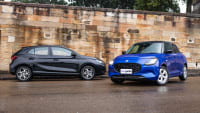Pop-up headlights: A great automotive idea or a fashion-driven waste of time? In truth, it’s probably a bit of both.
Pop-up headlight have been around for many decades, but they really became popular in the late 1970s and, particularly, the 1980s. This could suggest that they’re a fashion item, but it’s worth remembering this was also a time when fuel economy and emissions became more important to carmakers than they had ever been.
And that’s the point, because, in most cases, there was an aerodynamic consideration when cars were designed with pop-up headlights. And that’s probably their greatest advantage; they can make a car’s frontal area smaller and, therefore, potentially improve a car’s fuel efficiency. When they’re shut anyway.
Other advantages include the fact that a headlight hidden by a metal or plastic shield is less likely to be damaged by a flying rock or piece of road debris. Oh, and on the right make and model, cars with flip-up headlights could look super-cool. Not all cars, however, as some just never pulled it off style-wise.
Disadvantages? Plenty. For a start, a pop-up headlight assembly is inevitably heavier than the headlight unit on its own. And by the time you’ve added the mechanism that opens and closes the pop-up aspect, and the wiring to operate it, there’s definitely a mass penalty to pay.
They’re expensive to engineer and make, too. Anything that moves requires something to move it and in the case of a pop-up headlight, that’s usually an electric motor and a range of linkages and connections to make both lights emerge at the same time.
In some cases, the pop-up party trick is achieved with hydraulics or even vacuum from the engine. The list of things that could go wrong was a pretty long one. Other cars used hydraulics. Same same.

So why else did pop-up headlights go away? A couple of reasons, but mostly because carmakers figured out ways of making cars just as slippery aerodynamically without resorting to hiding the headlights.
As our understanding of aerodynamics improved, it turns out small frontal area is not the only concern, and an overall aerodynamic pure shape is far more important.
The concept of covering a headlight with a sleek Perspex or glass cover – something carmakers like Ferrari and Jaguar were using in the 1960s – re-emerged.

Also, as lighting technology started to embrace physically smaller LED light units, there was less physical headlight to hide in the first place.
Put simply, modern cars with LED lights don’t need pop-ups. Throw in the weight and cost penalty, and you can see why modern cars often don’t bother with this tech.
Back in the day, the US carmakers were obsessed with pop-up headlights, although they weren’t always pop-ups (even if a lot were, like the C3 Corvette, to name one well known model).

Instead, cars like various Lincolns and Cadillacs (and the 1968/69 dodge Charger of Dukes of Hazzard fame) used covers over the headlights.
These covers retracted or folded away to expose the light, so it wasn’t a true pop-up light. It was also mainly for show as the idea of aerodynamic efficiency in a Cadillac the size of a small house never really entered into things.
Plenty of Japanese cars embraced pop-up lights, too. For a while there, heaps of JDM cars had them, and makers like Mazda and Toyota were very keen on the concept. Nissan was in on the act at the same time, too, with various SX coupe models, the Z21 300ZX and even the tiny little EXA all pop-up headlight cars.

In Europe, the trend caught on to, with notable examples being the BMW 8-Series (and the earlier M1, of course).
Ferrari had a few models with this tech and even Porsche got in on it with the 924, 944 and 968 sporting pop-ups as well as the weird combination of a pop-up headlight that didn’t live behind a cover of any sort in the 928.
Instead the 928’s lights laid back in their cubby holes, staring at the sky, until the driver switched on the lights, at which point the headlights rolled up into position like a pair of frog’s eyes.

Pop-up lights are, to this day, one of the most memorable things about this generation of Japanese cars, and the MX-5 or Miata pop-up headlights continue to define the design in a visual sense.
That means you don’t need to buy something exotic to get this groovy feature. In fact, there are plenty of cheap cars with pop up headlights now, just make sure they work properly as part of the inspection of any second-hand car for sale.
Remember, too, old cars with technology like this won’t be affordable cars if anything serious goes wrong.

In Australia, we didn’t escape the trend, either. The 1990s Ford Capri, designed primarily as an export to the North American market, had pop-ups, and so did the Holden VL Calais, in an attempt to differentiate it from the less expensive Commodore and Berlina models.
Even then, the Calais wasn’t a standard pop-up system and, instead, left the lower half of the headlight glass exposed while using a lifting eyebrow to expose the full lens when the lights were switched on.
Our favourite pop-up headlight car? Let’s hear it for the Opel GT, built between 1968 and 1973 and sold mainly in Europe. This looked like a scaled-down C3 Corvette, so the covered headlights looked right.

But instead of a motor or hydraulics or vacuum opening them, the GT had a simple, mechanical linkage with a lever next to the centre console.
When the driver yanked on that, the headlights didn’t pop-up, but instead rolled over through 180 degrees to reveal their lenses to the world. Brilliant.
.jpg)
.jpg)

.jpg)
.jpg)
.jpg)












_0.jpg)
.jpg)
.jpg)

.jpg)

